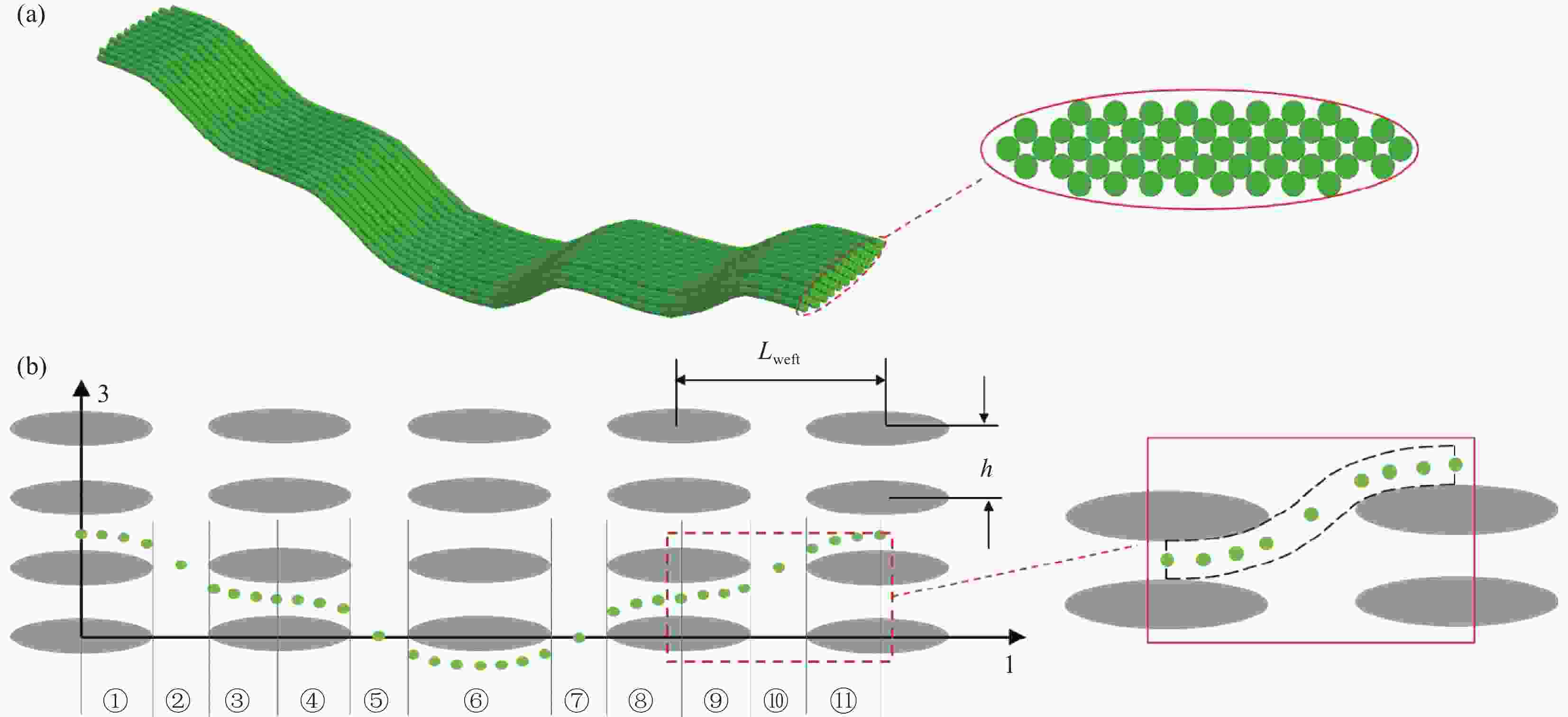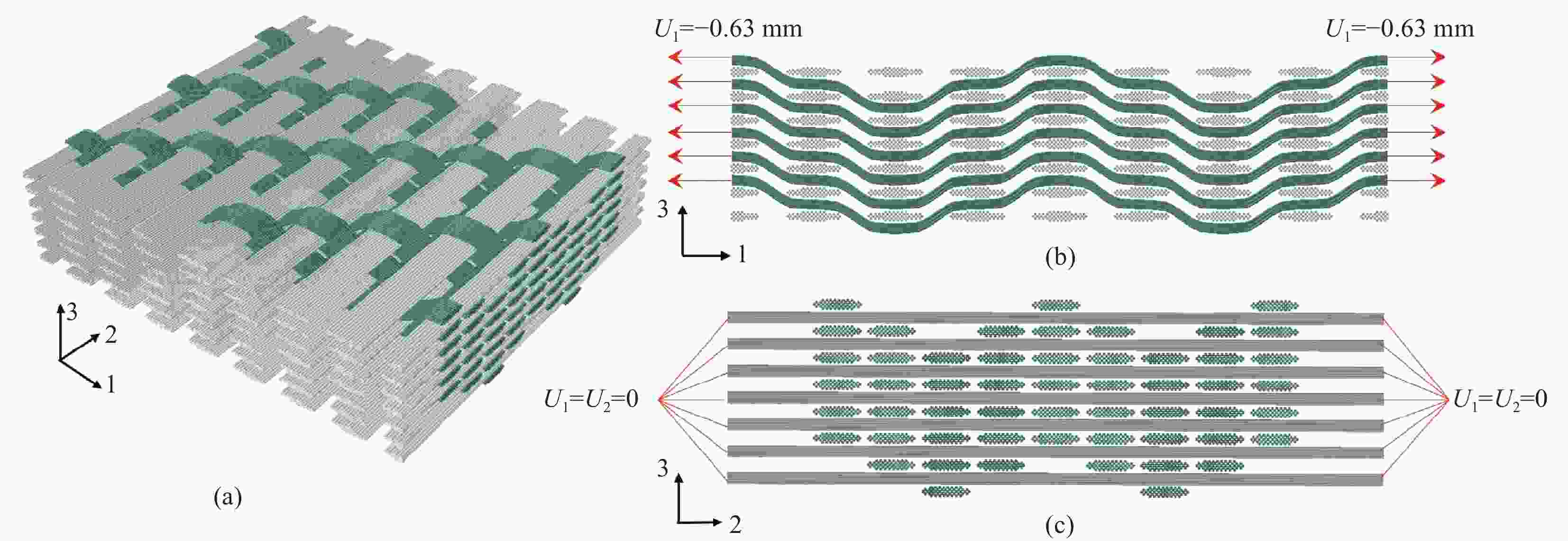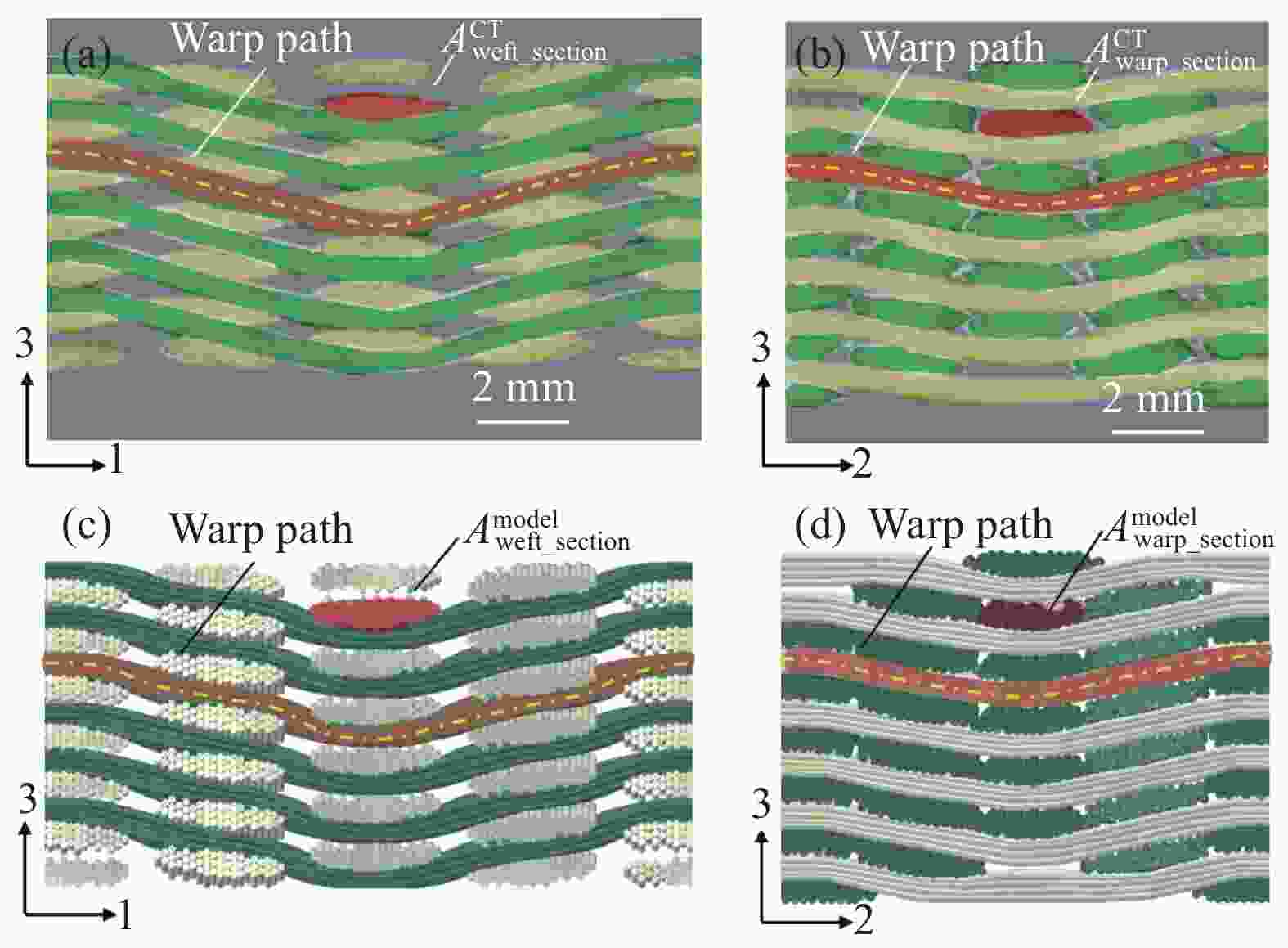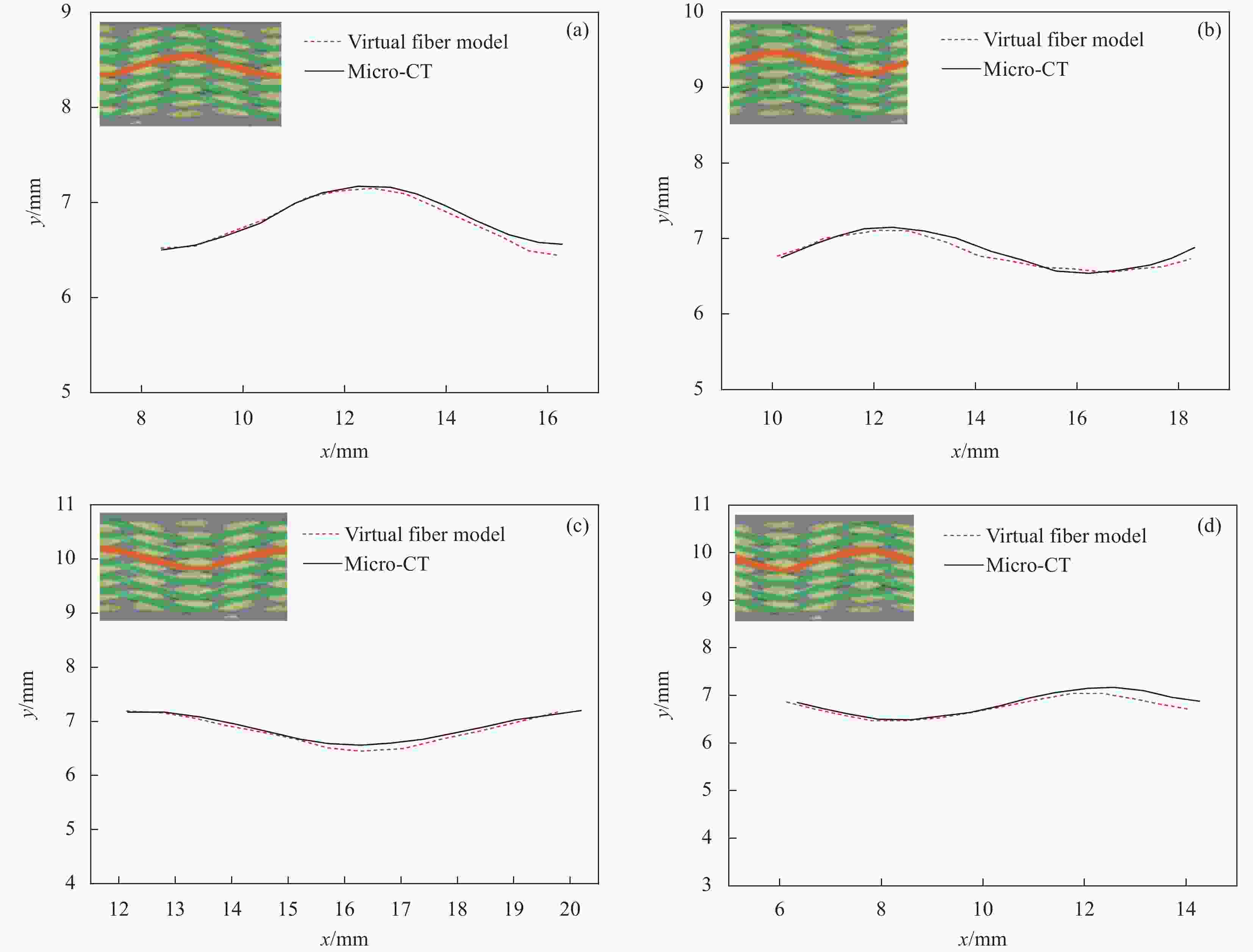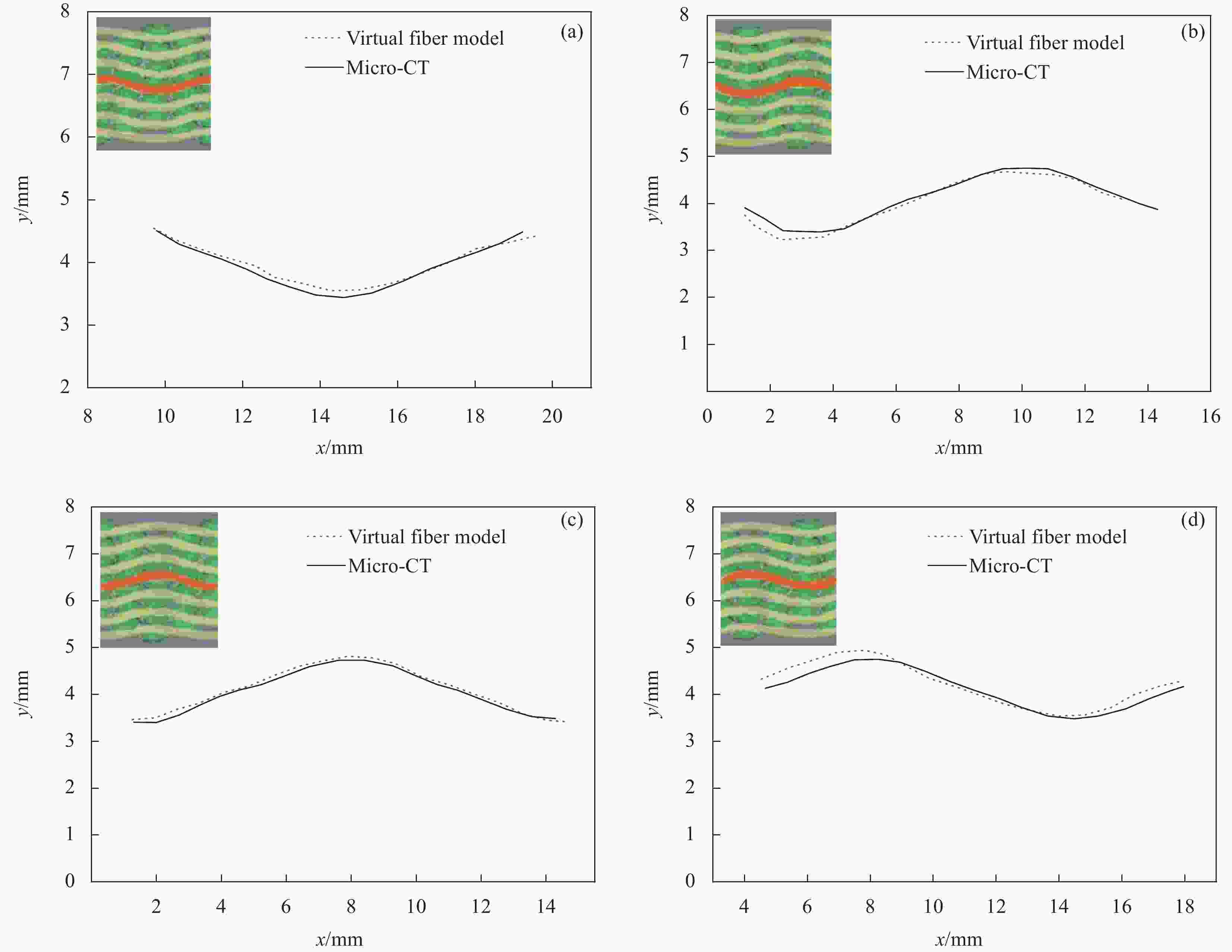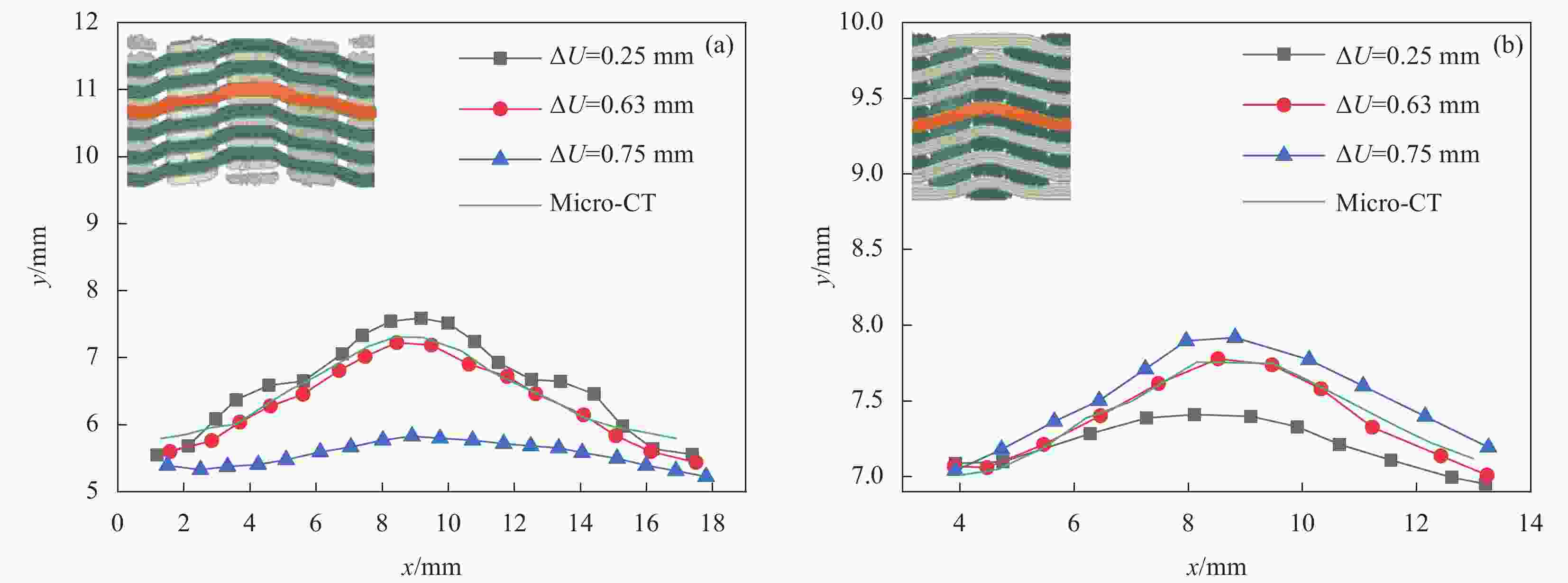Quasi-fiber scale modelling of 3D woven preforms
-
摘要: 3D机织复合材料在航空航天领域有着广泛应用,作为复合材料的增强结构,纤维预制体的几何构造对复合材料的力学性能有着决定性影响。但预制体是一种柔性结构,在成型过程中容易发生显著的几何结构变异,包括纱线路径的变化和截面的挤压变形。实现预制体的精细化、高保真度建模是对复合材料进行性能预测和结构设计的重要前提。针对碳纤维3D机织预制体的复杂纤维结构,基于虚拟纤维的概念提出了准纤维尺度建模方法,模拟了织造过程中纱线的运动和变形,实现了预制体的精确重构。利用Micro-CT技术表征了预制体样件的内部单胞结构,验证了模型的可靠性。Abstract: 3D woven composites are widely used in the aerospace field. As a reinforcement structure, the geometry of fiber preform has a decisive influence on the mechanical properties of composites. However, a preform is a flexible structure that is prone to significant geometric variation during the molding process, including yarn path changes and compressive deformations of cross-sections. Achieving refined and high-fidelity modeling of preforms is an important prerequisite for performance prediction and structural design of composite materials. Aiming at modeling of the complex fiber structure for carbon fiber 3D woven preforms, a quasi-fiber scale modeling method based on the concept of virtual fiber was proposed. Movements and deformations of yarn in the weaving process were simulated, and high precision model of 3D woven preform was constructed. The Micro-CT technology was used to analyze the unit cell structure inside the preform sample, which verified the reliability of the model.
-
Key words:
- 3D woven preform /
- virtual fiber /
- woven composites /
- Micro-CT technology /
- fiber structure /
- modelling
-
图 7 纱线几何信息提取:((a), (b)) Micro-CT图像;((c), (d)) 虚拟纤维模型
Figure 7. Geometric information extraction of the yarns from: ((a), (b)) Micro-CT images; ((c), (d)) Virtual fiber model
$A_{\rm{weft\_section}}^{\rm {CT}}$—Area of the weft cross-section in the CT image; $A_{{\rm{weft\_section}}}^{{\rm{model}}}$—Area of the weft cross-section in the virtual fiber model; $A_{{\rm{warp\_section}}}^{{\rm{CT}}} $—Area of the warp cross-section in the CT image; $A_{{\rm{warp\_section}}}^{{\rm{model}}}$—Area of the warp cross-section in the virtual fiber model
表 1 3D机织预制体建模参数
Table 1. Modeling parameters of 3D woven prefabrications
Modeling parameter aweft bweft bwarp Lweft h Value/mm 2.450 0.550 0.600 1.188 0.064 Notes:aweft, bweft—Major and minor axes of the weft cross-section; bwarp—Minor axes of the warp cross-section. -
[1] 陈利, 焦伟, 王心淼, 等. 三维机织复合材料力学性能研究进展[J]. 材料工程, 2020, 48(8):62-72. doi: 10.11868/j.issn.1001-4381.2020.000210CHEN Li, JIAO Wei, WANG Xinmiao, et al. Research progress on mechanical properties of three-dimensional woven composites[J]. Journal of Materials Engineering,2020,48(8):62-72(in Chinese). doi: 10.11868/j.issn.1001-4381.2020.000210 [2] 杜善义. 先进复合材料与航空航天[J]. 复合材料学报, 2007, 24(1):1-12. doi: 10.3321/j.issn:1000-3851.2007.01.001DU Shanyi. Advanced composite materials and aerospace engineering[J]. Acta Materiae Compositae Sinica,2007,24(1):1-12(in Chinese). doi: 10.3321/j.issn:1000-3851.2007.01.001 [3] 刘强, 赵龙, 黄峰, 等. 机织复合材料风扇叶片成型技术研究[J]. 纤维复合材料, 2019, 36(4):68-72.LIU Qiang, ZHAO Long, HUANG Feng, et al. Study on forming technology of woven composite fan blades[J]. Fiber Composites,2019,36(4):68-72(in Chinese). [4] 杨志, 焦亚男, 谢军波, 等. 纺织复合材料纤维预制体力学性能测试方法研究进展[J]. 复合材料学报, 2022, 39(4):1511-1533. doi: 10.13801/j.cnki.fhclxb.20210820.001YANG Zhi, JIAO Yanan, XIE Junbo, et al. Research progress on mechanical properties test methods for textile composite fiber preforms[J]. Acta Materiae Compositae Sinica,2022,39(4):1511-1533(in Chinese). doi: 10.13801/j.cnki.fhclxb.20210820.001 [5] JUAN P, VALTER C , STEPAN V L. Micro-CT analysis of the internal deformed geometry of a non-crimp 3D orthogonal weave E-glass composite reinforcement[J]. Composites Part B: Engineering,2014,65:147-157. doi: 10.1016/j.compositesb.2013.11.024 [6] BARBURSKI M, STRAUMIT I, ZHANG X W, et al. Micro-CT analysis of internal structure of sheared textile composite reinforcement[J]. Composites Part A: Applied Science and Manufacturing,2015,73:45-54. doi: 10.1016/j.compositesa.2015.03.008 [7] 邵梦洁, 谢军波, 杨志, 等. 基于Micro-CT技术的3D机织预制件细观结构分析[J]. 复合材料学报, 2022, 39(8):4129-4138.SHAO Mengjie, XIE Junbo, YANG Zhi, et al. Meso-structure analysis of 3D woven precast parts based on Micro-CT technology[J]. Acta Materiae Compositae Sinica,2022,39(8):4129-4138(in Chinese). [8] YANG Z, JIAO Y, XIE J, et al. Modeling of 3D woven fibre structures by numerical simulation of the weaving process[J]. Composites Science and Technology,2021,206(8):108679. [9] MENGRAN L, KAI L, GE J R, et al. A novel modeling method for the mechanical behavior of 3D woven fabrics considering yarn distortion[J]. Composites Science and Technology,2022,230:109691. doi: 10.1016/j.compscitech.2022.109691 [10] LIU Z F, GE J R, LIU K, et al. High-fidelity modeling of 3D woven composites considering inhomogeneous intra-yarn fiber volume fractions[J]. Composite Structures,2022,290:115505. doi: 10.1016/j.compstruct.2022.115505 [11] ISART N, EL SAID B, IVANOV D S, et al. Internal geometric modelling of 3D woven composites: A comparison between different approaches[J]. Composite Structures,2015,132:1219-1230. doi: 10.1016/j.compstruct.2015.07.007 [12] ISART N, MAYUGO J A, BLANCO N, et al. Geometric model for 3D through-thickness orthogonal interlock composites[J]. Composite Structures,2015,119:787-798. doi: 10.1016/j.compstruct.2014.09.044 [13] ZHENG T, GUO L C, HUANG J Z, et al. A novel mesoscopic progressive damage model for 3D angle-interlock woven composites[J]. Composites Science and Technology,2020,185:107894. doi: 10.1016/j.compscitech.2019.107894 [14] NAOUAR N, VASIUKOV D, PARK C H, et al. Meso-FE mo-delling of textile composites and X-ray tomography[J]. Journal of Materials Science,2020,55(36):16969-16989. doi: 10.1007/s10853-020-05225-x [15] WINTIBA B, VASIUKOV D, PANIER S, et al. Automated reconstruction and conformal discretization of 3D woven composite CT scans with local fiber volume fraction control[J]. Composite Structures,2020,248:112438. doi: 10.1016/j.compstruct.2020.112438 [16] STRAUMIT I, LOMOV S V, WEVERS M. Quantification of the internal structure and automatic generation of voxel models of textile composites from X-ray computed tomography data[J]. Composites Part A: Applied Science and Manufacturing,2015,69:150-158. doi: 10.1016/j.compositesa.2014.11.016 [17] HUANG W, CAUSSE P, BRAILOVSKI V, et al. Reconstruction of mesostructural material twin models of engineering textiles based on Micro-CT aided geometric modeling[J]. Composites Part A: Applied Science and Manufacturing,2019,124:105481. doi: 10.1016/j.compositesa.2019.105481 [18] YANG H, WANG W F, SHANG J C, et al. Segmentation of computed tomography images and high-precision reconstruction of rubber composite structure based on deep learning[J]. Composites Science and Technology,2021,213:108875. doi: 10.1016/j.compscitech.2021.108875 [19] SINCHUK Y, KIBLEUR P, AELTERMAN J, et al. Variational and deep learning segmentation of very-low-contrast X-ray computed tomography images of carbon/epoxy woven composites[J]. Materials,2020,13(4):936. doi: 10.3390/ma13040936 [20] EMERSON M J, JESPERSEN K M, DAHL A B, et al. Indivi-dual fibre segmentation from 3D X-ray computed tomography for characterising the fibre orientation in unidirectional composite materials[J]. Composites Part A: Applied Science and Manufacturing,2017,97:83-92. doi: 10.1016/j.compositesa.2016.12.028 [21] DONG S, WANG P, ABBAS K. A survey on deep learning and its applications[J]. Computer Science Review,2021,40:100379. doi: 10.1016/j.cosrev.2021.100379 [22] 李昊东. 基于全卷积网络改进的图像语义分割应用研究[D]. 南京: 南京邮电大学, 2019.LI Haodong. Research on application of improved image semantic segmentation based on fully convolutional network[D]. Nanjing: Nanjing University of Posts and Telecommunications, 2019(in Chinese). [23] WANG Y Q, SUN X K. Digital-element simulation of textile processes[J]. Composites Science and Technology,2001,61(2):311-319. doi: 10.1016/S0266-3538(00)00223-2 [24] XIE J B, CHEN X M, ZHANG Y F, et al. Experimental and numerical investigation of the needling process for quartz fibers[J]. Composites Science and Technology,2018,165:115-23. doi: 10.1016/j.compscitech.2018.06.009 [25] XIE J B, FANG J, CHEN L, et al. Micro-scale modeling of 3D needled nonwoven fiber preforms[J]. Composite Structures,2022,281:114995. doi: 10.1016/j.compstruct.2021.114995 [26] 郭珍珍, 谢军波, 焦伟, 等. 碳纤维3D机织预制体弯曲性能[J]. 复合材料学报: 2023, 40(6): 3396-3404.GUO Zhenzhen, XIE Junbo, JIAO Wei, et al. Bending properties of carbon fiber 3D woven preforms[J]. Acta Materiae Compositae Sinica, 2023, 40(6): 3396-3404(in Chinese). [27] LIU C, XIE J B, SUN Y, et al. Micro-scale modeling of textile composites based on the virtual fiber embedded models[J]. Composite Structures,2019,230:111552. doi: 10.1016/j.compstruct.2019.111552 -






 下载:
下载:

